3 Fundamentals of Geology and Microbiology
Jason Kelsey
In Chapter 1 we learned that environmental science is a relatively new, interdisciplinary, field concerned with the interactions among the living and non-living systems on Earth. The task is broad, and it requires insights and tools from many of the older, disciplinary sciences. We will review basic principles in chemistry, biology, and physics, for example, as they become necessary. Given the amount of critical context they will provide for us throughout this textbook, and the relative unfamiliarity people tend to have with them, geology and microbiology will receive special consideration here.
Key concepts
After reading Chapter 3, you should understand the following:
GEOLOGY
- The internal structure of the Earth and what it tells us about our planet’s history
- The theory of plate tectonics and how moving plates shape the living and non-living components of Earth
- How rocks are formed, changed, and destroyed by the many processes of the rock cycle
- How geologists study Earth’s history
- The nature of geologic time
- How knowledge of geology is important to environmental scientists
MICROBIOLOGY
- The basic structures of different cell types
- The major characteristics and roles of bacteria, fungi, algae, protozoa, and viruses
- How humans can harness microbiology for our own use
- How knowledge of microbiology is important to environmental scientists
Chapter contents
3.1. Geology
3.2. Microbiology
The Chapter Essence in Brief
3.1. GEOLOGY
Geologists primarily study Earth’s physical structures and history. If you recall the scope of environmental science from your reading of Chapter 1, the utility of geology to us should be, therefore, clear. First, since organisms are inextricably linked to their physical environments, geology helps us understand the stressors shaping the biosphere (we will learn more about this and other spheres in Chapter 4; for now, biosphere refers to all the living things on Earth). Some of these are sudden and short-lived events, for example earthquakes and volcanic eruptions (Chapter 7), whereas others require longer periods of time, such as climate change (Chapter 14), as well as the creation and destruction of landforms and bodies of water (this chapter, below). Second, geology provides evidence of Earth’s tremendous age and explains how slow and steady processes can dramatically alter physical features that might appear stagnant when viewed on a human time scale. Finally, knowledge of geologic forces and history can help uncover naturally occurring resources such as water, fuels, and minerals. As we will see in part two of this textbook, locating and managing these and other materials is of great concern to environmental scientists.
Here we will only briefly consider the principles of geology most relevant to our study of Earth’s natural systems. You should keep in mind, however, it is a very wide-ranging, and this short primer cannot possibly do justice to all its subdisciplines and complexities.
3.1.1. A dynamic Earth
It can be tempting to view our planet as static and, for all intents and purposes, permanent. In fact, the prevailing thought throughout much of human history was that Earth’s surface has been the same since its beginning. Only relatively recently did people start to seriously consider the possibility that landforms and bodies of water are temporary, even if long lived. Using several important principles, including the two included below, current-day geologists understand the Earth to be ever changing.
The theory of plate tectonics and the tectonic cycle
This is one of the most foundational and influential ideas developed by geologists during the past century. It describes a plausible mechanism by which the surface of the planet is shaped and reveals that, contrary to long-held opinions, large-scale changes to the size and shape of mountains, continents, and oceans have occurred during the past and will continue into the future. The main points of the theory are as follows.
Earth is neither solid nor homogeneous.
Chemistry changes with depth
As shown in Figure 3.1, the Earth is divided into three layers based largely on chemical composition (more about Chemistry is presented in Chapter 4).
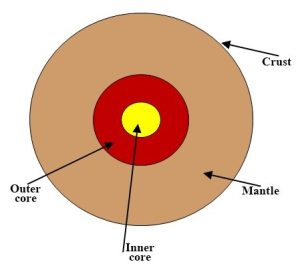
Crust. This zone ranges from 0 – 50 km deep (its dimensions vary and can be as thin as 10 km in some places). It is the exterior shell covering the entire outside of the globe. It is mostly comprised of low-density materials such as oxygen, silicon, and aluminum. Substances like iron and magnesium, which are relatively dense, are present in small amounts. Temperatures in this layer range from what can be found at the surface (down to about 0 °C) to near 400 °C in its deepest sections.
Mantle. Ranging from 40 – 2900 km deep, this much thicker section lies between the crust and the core and makes up the bulk of Earth’s volume. It too contains oxygen and silicon, but magnesium and iron are present in higher amounts here than in the crust. Temperatures in this layer range from about 400 °C in the upper portions to about 4000 °C near the core (next item).
Core. The center of the Earth (2900 – 5150 km depth) is thought to contain two portions, an inner solid core and an outer molten core. Dense iron and nickel dominate, and only small amounts of oxygen and silicon are present here. Temperatures in this layer are likely on the order of about 5000 °C.
Physical properties change with depth
Materials beneath the surface also can be categorized according to their physical behavior, resulting in three fundamental layers.
Lithosphere. As we will see in Chapter 4, this is one of the four spheres of concern to environmental scientists. In simple terms, the lithosphere is made up of the crust and upper portions of the mantle and extends to depths of about 100 km. Materials in this layer are hard and brittle, that is, they tend to break when stress is applied to them.
Asthenosphere. This zone is made up of deeper portions of the mantle, down to about 200 km. Here, materials are plastic instead of brittle. So, when stress is applied to them, they do not break; instead, they move a bit like a very viscous liquid, changing shape without fracturing.
Mesosphere. This encompasses the lower portion of the mantle and extends to the core.
The lithosphere floats on the asthenosphere
Since the lithosphere is comprised of the relatively low-density crust and upper mantle, it sits atop the higher-density materials in the asthenosphere. Figure 3.2 shows the position of these two layers.
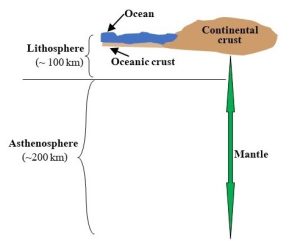
The lithosphere is made up of large pieces
The brittle lithosphere is not one continuous layer but instead is broken into irregular units referred to as tectonic plates. These plates move slowly along the surface of the plastic asthenosphere. Figure 3.3 shows a map view of the 15 major plates making up the bulk of the lithosphere.

Moving plates interact. On average, plates move about 2 cm each year. Since they are sliding along the surface of the same globe, all plates share boundaries with other plates. Several important processes are active at these boundaries, including production and destruction of new crust, formation of mountains and volcanoes, and induction of earthquakes (more in Chapter 7). Three basic types of interactions are possible (Figure 3.4).
Divergent (Fig. 3.4a)
At this boundary type, plates are moving away from each other. As a result, a long thin opening is formed in the lithosphere. New crust is produced as molten rock rises from the mantle to the surface where temperatures are low enough for solid rocks to form (more about rock formation is described later in the chapter). The crack running approximately 16,000 km north-south in the middle of the Atlantic Ocean is a good example of a divergent boundary. This structure, the Mid Atlantic Ridge, is confined to the ocean floor except for a small area that makes up Iceland.
Convergent (Fig. 3.4b)
Here, plates move toward each other, colliding at their boundary. Two broad outcomes are possible. In the first, one of the plates dives below the other in a process known as subduction. If this occurs, old crust sinks into the mantle, melts, and is absorbed into the asthenosphere. Some of that melted material rises toward the surface and can lead to volcanic activity (Chapter 7). The Andes Mountains in Western South America provide a good example of the result of this type of plate interaction. Second, there is no subduction. Instead, the two plates produce tall mountains because the only direction the colliding rocks can move is upward. The Himalaya Mountains in Asia illustrate this phenomenon. Keep in mind that the lateral pressure associated with plate movements can ultimately cause uplift, a process whereby rocks on the ocean floor or in other low places are pushed to higher elevations. We will see that uplift plays a critical role in the recycling of many of Earth’s materials (Chapter 4).
Transform (Fig. 3.4c)
These boundaries are different from the others because plates slide along next to each other, grinding and scraping as they move. It is fair to say that crust is displaced in these zones rather than created or destroyed, and earthquakes (Chapter 7) are a typical result. Arguably, the most famous of these is present between the North American and Pacific plates and is responsible for the San Andreas Fault in Southern California (U.S.A.).
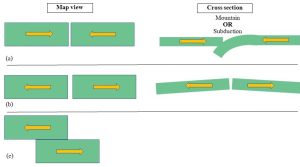
Plate movements matter. It would be difficult to overstate the importance of plate movements. Their constant motion subjects the Earth’s surface to unrelenting change. As we saw above, plate interactions alter landforms and trigger earthquakes and volcanic eruptions. Moreover, continents and ocean basins are slowly created, shaped, and destroyed due to tectonic forces. One well-studied example of the power of moving plates is seen in Pangaea, an extinct supercontinent that was once a single landmass made up of all Earth’s modern continents. About 200 million years ago, plate movements led to the break-up of Pangaea, creating isolated landmasses, including North America and Africa, and bodies of water, such as The Atlantic Ocean (See Figure 3.5).

What drives plate movements? Much evidence supports the premise that lithospheric plates are in motion and carry Earth’s crust with them (see below for more on the development of the theory of plate tectonics). But, just how giant lithospheric plates move across the surface has been the subject of study and debate for some time. Although no definitive and universally accepted answer has yet been found, a few possible mechanisms have been proposed. The dominant idea for several decades held that plates were propelled by convection cells in the mantle: circular motion is initiated as hot material rises at divergent boundaries and cold material sinks at convergent ones. As happens so often in science, though, recent data have caused us to revise our understanding. Additional proposals have been put forward, including the possibility that gravity plays a large role. More research is clearly needed to work out this problem.
The evidence for plate movements is abundant. As we learned in Chapter 2, the scientific method involves several steps and helps us study the rules that govern the Universe. Importantly, generalizations posited by scientists must be supported by objective evidence if they are to be taken seriously. The story of plate tectonics provides a great example of the way science was used to slowly develop a widely accepted theory. It began with an observation made in the 17th Century that many of the coastlines of the world’s continents appeared to be complementary, like puzzle pieces. Was this mere coincidence or had these edges once been connected to each other? As outrageous as it seemed to many people, the following hypothesis was offered: the Earth’s continents are not stationary, but instead, move. A single, giant landmass of the past somehow broke apart, resulting in the current arrangement. The notion of continental drift was born. In subsequent years and centuries many scientists collected data to test the hypothesis. Along with other pieces of evidence, the following five have elevated this idea to a theory.
1. The puzzle fit
Although coastlines are complimentary, the fit is even better if continental shelves (the coastal edges submerged by ocean) are considered. See Figure 3.6.a.

2. Fossil evidence
Fossils (preserved remains of ancient life forms) of the same land-based organisms are present on continents separated by wide oceans (Figure 3.6.b).
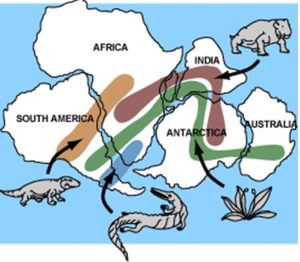
Of the three most likely explanations offered by science, (c) is the one best supported by evidence.
(a) The same organism, with the same adaptations and traits, would have developed at the same time under different environmental conditions, for example in Australia, Africa, and South America. As we learned in Chapter 1, organisms are shaped by the specific stressors acting on them, and it is hard to imagine how identical organisms could develop in response to different temperature, light, nutrition, moisture, etc., conditions. We will return to these ideas in Chapters 5 and 6.
(b) The organisms would have migrated by swimming across thousands of kilometers of oceans, despite their apparent inability to do so (i.e., they lacked proper adaptations).
(c) The organisms developed, lived, and died on a large landmass made up of modern-day continents. After their remains were fossilized, the landmass broke up. Again, geologists have embraced this idea as the most probable, particularly when combined with all the other evidence supporting the idea of continental drift.
3. There’s an ocean in the middle of a mountain range
Rocks and mountains of the same age, and with the same properties, can be seen on the western and eastern edges of the Atlantic Ocean. So, during a trip north through the Appalachian Mountains (USA) to the coast of Nova Scotia, you would notice the mountains end where the ocean begins. If you then boarded a plane and flew east, you would see the Caledonian Mountains begin at the coast of England and continue into Scandinavia (Figure 3.6.c).
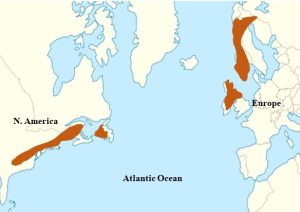
A study of the two mountain ranges would reveal something you might consider startling: they appear to have the same features, rocks, and fossils in them. Geologists interpret these findings to mean a single mountain range formed while the continents were part of Pangaea. After the continents moved away from each other, two separate yet identical landforms persisted on either side of a large ocean. Most scientists find the alternative explanation, that the mountains formed simultaneously in different locations, to be far less plausible.
4. Glacial remains in tropical areas
Glacial evidence found on the separate landmasses is inconsistent with stationary continents for the following reasons (Figure 3.6.d).
(a) Remains of past glacial events are present in areas that were too warm to support year-round ice (climate conditions have been estimated by a study of rocks of the same age).
(b) The patterns left behind by moving glaciers have been well studied and can only be reasonably explained if a single landmass was covered by ice before it broke apart. Then, after the continents drifted, the remains of the ancient glaciers were left in present day South America, Africa, Asia, Australia, and Antarctica. Otherwise, the past glacial movements do not make any sense.

5. Ocean-floor symmetry
Ocean-floor features on either side of the Mid Atlantic Ridge (i.e., the divergent plate boundary that divides the Atlantic Ocean) are symmetrically arranged, suggesting a spreading center. Chemical tests used to calculate the age of rocks yielded a crucial finding: materials in the center of the ocean, in and around the volcanic crack, are youngest, and ages increase as one travels toward North America and Africa. Notably, the age arrangement is symmetrical around the ridge, and the ages of the rocks on the coast of each continent are the same, about 200 million years old (Figure 3.6.e).
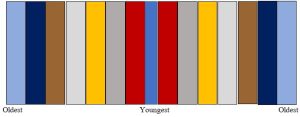
Geologists conclude from these data that North America and Africa started to pull away from each other (roughly west and east) around 200 million years ago. The boundary between them was (and continues to be) a linear opening through which molten materials rise and then cool; the resulting rocks form new crust. In other words, the Atlantic basin has been increasing in size since Pangaea began to split. Other analyses have revealed similar arrangements of certain chemical properties in other oceans, further supporting the continental drift hypothesis.
How is the theory of plate tectonics useful? The emergence of this theory profoundly affected the way we view Earth. Geologists use their understanding of plate tectonics to help reconstruct the planet’s long history and aid in their study of important phenomena. For example, the theory provides an explanation for continental drift and informs the study of the distribution and evolution of past and present organisms. It also provides some capacity to predict earthquake and volcanic activity (Chapter 7).
The rock cycle
Like mountains and other landforms, rocks can persist for very long periods of time, millions or even billions of years. Ultimately, though, they are temporary structures. The rock cycle describes the processes responsible for the formation, modification, and destruction of rocks. It is important to environmental scientists because it can be used to track the recycling of materials vital to many of Earth’s systems (see Chapter 4 for more about the movement and cycling of materials). The major processes of the cycle are briefly summarized below and in Figure 3.7. Note it is not linear but represents multiple possible trajectories and outcomes.
Crystallization. At very high temperatures, in the range of 600 – 1300 ºC, rock melts to a liquid (called magma if below the Earth’s surface and lava if on the surface). This molten material typically moves upward from hot zones into cooler ones until it crystallizes, or turns into solid igneous rocks.
Uplift, weathering, and erosion. Tectonic forces can move rocks from low elevations to high (i.e., the process of uplift). In addition, soils and rocks under which existing rocks are buried can be removed. Rocks affected by uplift or uncovering can then undergo weathering, a collection of processes that fragment or decompose them. For example, chemical reactions can break bonds between atoms found inside rocks (Chapter 4), or physical disintegration can occur when water freezes and expands within cracks. The products of weathering, known as sediments, are subject to erosion, that is, they are transported away in water, ice, or wind (so, although related, weathering and erosion are not the same). Some of these sediments become new rocks (see the next item on the list), whereas others are incorporated into soil, a material that has a profound effect on farming (Chapter 9).
Deposition and lithification. Sediments produced from weathering move downhill until they are dumped, or deposited, by the agent transporting them (e.g., moving water). Very often, these materials settle in the bottoms of lakes, rivers, and oceans. As layers of sediments accumulate on the floor of a given waterway, they are squeezed together and buried. Under the proper conditions, these materials are bound together in what is known as lithification, to become solid sedimentary rocks.
Burial of existing rocks. Rocks can be covered again by soils, sediments, and other rocks. If temperature and pressure increase sufficiently, physical and chemical alterations can produce metamorphic rocks. Note that temperatures are not high enough to melt the rocks, so only solid-state changes occur. Existing metamorphic rocks can continue to change as they are buried. Eventually, rocks become hot enough to melt, and the process can be said to repeat itself.
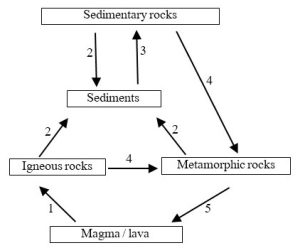
3.1.2. Geologic time
Earth has a long history
Data collected by geologists can be used to make a very good case that Earth is ancient, some 4.6 billion years old (see Box 3.1 for a brief explanation of the tools used to date the Earth). It will likely be unsurprising to you that describing such a vast stretch of time poses some substantial challenges. To help manage this enormous task, geologists have developed what is known as the geologic time scale (Table 1), a way to summarize major events that occurred during the past. It is divided into units based largely on fossils found in sedimentary rocks.
Table 3.1. Abbreviated Geologic Time Scale[1]. Note that about 90% of geologic time is compressed into the era known simply as Precambrian, i.e., the relative sizes of the eras indicated by the colors are not to scale. Ages are approximate. The term vertebrate refers to organisms with backbones, invertebrates lack backbones.
| Era | Period | Years ago (millions) | Notable events |
| Cenozoic | Quaternary | 0-2 | Modern humans appear |
| Tertiary | 2-65 | Mammals begin to dominate | |
| Mesozoic | Cretaceous | 65-144 | Dinosaurs become extinct |
| Jurassic | 144-213 | Dinosaurs dominate | |
| Triassic | 213-248 | First dinosaurs, mammals, birds appear | |
| Paleozoic | Permian | 248-286 | Modern insects appear |
| Carboniferious | 286-360 | First amphibians and reptiles appear | |
| Devonian | 360-408 | Plants with seeds and boney fish appear | |
| Silurian | 408-438 | First land plants appear | |
| Ordovician | 438-505 | First vertebrates appear | |
| Cambrian | 505-570 | Invertebrates dominate oceans | |
| Precambrian | 570-3800 | Prokaryotes dominate | |
| 4600 | Earth formed as molten ball |
Table 3.1 is one way to represent the time scale. We will not concern ourselves with the details, but you should note some important highlights (years given are approximate).
- Earth formed as a molten ball of material about 4.6 billion years ago.
- We have found no evidence of any organisms living before 3.8 billion years ago.
- Single-celled organisms known as prokaryotes were the only life forms present until 600 million years ago. More about these and other microbes can be found later in this chapter.
- Complex organisms made up of more than one cell(i.e., they are multicellular) did not appear until Earth was 4.0 billion years old.
- The ancient plants that became today’s coal died about 300 million years ago.
- Dinosaurs were present between 245 and 65 million years ago.
- Mammals (the group that includes humans) did not become relevant until after the extinction of the dinosaurs (more about extinction is presented in Chapters 5 and 6).
- Human-like organisms appeared 2 million years ago, although modern humans probably did not begin to develop until 200,000 years ago.
There are two approaches used to establish the age of Earth’s materials.

The relevance of time
Modern geology is underlain by one critical principle: Earth is extremely old. In fact, unless one allows for the billions of years of history supported by geologic evidence, it is essentially impossible to use science to explain the processes shaping both interior and surface features. Consider our discussion of plate tectonics, above. Given the slow rate of movement—on the order of 2 centimeters each year—hundreds of millions of years were required to form the Atlantic Ocean after Pangaea started to break up. Weathering and erosion of tall mountains also take an enormous amount of time. Depending on several variables, the rate of removal of materials is in the range of a millimeter per year. So, a structure that is many kilometers tall, like Mt. Everest in Asia, would take millions of years to be worn down.
The nature of past geologic processes
Generations of people have debated whether the physical features we observe today were primarily formed through sudden, rare events or as the result of slow, regular processes. One dominant and long-standing assumption that Earth is young, approximately 10,000 years old, allows for just the former explanation; that is, given the very limited amount of time available, dramatic and short-lived upheavals are the only possibility. Geologists of the past, therefore, had to somehow reconcile considerable evidence that Earth is shaped very gradually with the constraint that history was not sufficiently long—by many, many millions of years—to allow such obviously time-consuming mechanisms to produce mountains, oceans, and the like. Modern geologists find themselves in a different position, as described in the previous paragraph: they assume Earth is old enough for even weak yet steady processes to both form and alter surface structures. So, to return to a point made above, given enough time, just 1 millimeter per year of weathering can completely obliterate the tallest mountain range. Even with this expanded view of time, different proposals about Earth’s history persist.
Uniformitarianism. In short, this principle holds that the rules governing today’s world have always been in force. So, since we do not currently observe instantaneous formation of mountains, oceans, rivers, or valleys, we cannot assume that they sprung up quickly in the past either. We must instead draw upon the slow and steady forces working now to explain historical events. For example, if tectonic plates move slowly in the modern world, they must have done so in the past. Clearly, one of the major assumptions upon which Uniformitarianism is founded is that Earth is very ancient. Uniformitarianism is often summarized very succinctly in the following way: “The present is the key to the past.”
Catastrophism. Unlike Uniformitarianism, this idea assumes that the past must have been characterized by a much more active planet than we see today, one that featured many powerful forces working to quickly and profoundly shape the surface. For example, rather than requiring 200 million years to form, the Atlantic Ocean might have opened up overnight due to some mechanism that is no longer active. Importantly, catastrophism does not require an ancient Earth: everything currently present, and all the evidence suggesting billions of years of time, could have been produced in a few thousand years.
Geologic actualism. Our current model is a hybrid of the first two and holds that Earth goes through extended periods of relative quiet and inactivity, but short bursts of intense activity can quickly transform the surface. For example, as we see today, phenomena such as earthquakes and volcanic eruptions can bring about sudden changes, but day-to-day forces work slowly.
3.2. MICROBIOLOGY
We are absolutely surrounded by organisms we never see. Like it or not, bacteria, protozoa, fungi, and algae are in or on our food, water, air, skin, mouth, intestines, clothes, furniture, utensils, railings, toilets—the list is very, very long. It would be safe to say that very few places on this planet lack them. They tend to go unnoticed by most people, however, because of their extremely small size: without the aid of a magnifier (e.g., microscope), these organisms are invisible. Whether most humans are conscious of them, the enormity of their ongoing role cannot be overstated. A basic understanding of microbiology is therefore indispensable to a study of environmental science. Like our approach to geology in the first part of this chapter, we will only take a brief look at this broad and complex field.
3.2.1. Cells
All organisms, including those of interest to microbiologists, are made up of at least one microscopic unit known as a cell. The properties and ideas about cells most important to us are as follows.
A small system
A cell can be thought of as a living system, one that receives inputs such as nutrients and information and releases outputs such as waste products. Sizes range from around 1 µm (a micron, or 0.0000001 meter) in prokaryotes to 10 µm in eukaryotes.
Distinct from its environment
Cells live within an environment (e.g., soil or water) but are identified as distinct entities by their cell membrane (also called the plasma membrane), a flexible outer boundary that controls much of what passes in and out of them. Some cells have an additional rigid boundary known as a cell wall (Figure 3.9).
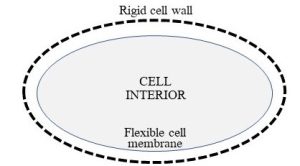
Component parts
The interior of a cell (i.e., the space enclosed within the cell membrane) contains water and several other sub-cellular structures. Eukaryotic cells have well-defined interior components, or organelles, surrounded by their own membranes. Possibly the most famous of these is the nucleus, the site of information storage. There are others, though, including mitochondria, organelles responsible for maintaining appropriate cellular energy levels. On the other hand, prokaryotic cells lack distinct membrane-bound organelles. Many of the same tasks (and more) carried out by eukaryotic organelles can be accomplished within prokaryotic cells, but the interior structures are less obvious and well defined in the latter. See Figure 3.10, a simple and generalized diagram of different cell types.
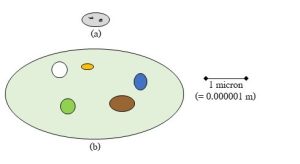
Reproduction
Cells can copy themselves and produce offspring through a variety of mechanisms (Chapters 5 and 6).
How many cells per organism?
Most microorganisms are unicellular, that is, made up of just one independent cell. Some organisms are multicellular: they are made up of many cells (in the case of humans, something like 1013 native cells!) that interact to form a larger living system. Colonial is a third type of growth, and involves many individual cells that occur together, interact, and probably communicate, but their interdependence and specialization are not as developed as they are for true multicellular organisms.
3.2.2. The microorganisms
We learned that these are too small to be seen with the naked eye. Other than their size, though, it would be wrong to assume they are all the same—this is an immensely diverse assemblage. To simplify things, microorganisms are subdivided into five groups, each with several important defining characteristics.
Bacteria
Relative simplicity. They are prokaryotic, unicellular, short lived, and fast growing.
Adaptability. Having fast growth and relative simplicity, they can quickly and effectively respond to stressors (Box 3.2). This trait enables their long-term success (Chapters 1, 5, and 6) but also can create some substantial human health concerns such as the development of antibiotic-resistant bacteria (Chapter 5).
Two important traits give bacteria a remarkable ability to quickly adapt to changing environmental conditions. First, their DNA is very simple compared to that found in eukaryotes. Why does this matter? DNA is the molecule in which all the information needed to make a copy of a cell is kept (also called its genome). It can be thought of as a code that is translated into physical traits such as size, shape, and chemical properties. If a change or mutation to the code occurs (a common event), then the dependent traits are likely to be altered as well. Often, the result is bad for the cell, but sometimes the new traits provide an advantage in descendent cells (Chapter 6). DNA can be classified as simple, as it is in bacteria, if it only carries information that is converted into tangible characteristics. For the most part, bacterial genomes contain no extraneous information—all the code is put to use. In humans and other eukaryotes, the genome is far more complicated. Importantly, although our DNA certainly carries information that is decoded to construct physical structures and dictate basic characteristics (e.g., eye, hair, and skin color) it also contains sections that go largely unused. Thus, a mutation to our DNA is not guaranteed to affect any observed traits, particularly if the change occurs to one of those untranslated sections (Chapter 6). There are other important differences, but the bottom line is: mutations are much more likely to bring about fast and obvious changes as genomes get simpler. Second, bacteria reproduce extremely rapidly. In some cases, a new generation of cells will appear every 10 minutes, a far cry from the decades typically needed for the human population to double. This enormous time difference is relevant because substantial changes to the characteristics of bacterial offspring could become evident within a few hours, allowing for rapid adaptation to new stressors (See also Box 5.3). Many millennia (or much more) are likely to elapse before mutations to animal genomes are relevant, if they ever manifest at all.
Distribution. Members of this group can be found in nearly every environment on Earth, from deep oceans to mountain tops to deserts to forests to soils to other organisms. They can survive a range of conditions relative to oxygen and light availability, in some cases even thriving in frozen, boiling, acidic or other extreme places. Not surprisingly, the word ubiquitous is often used to describe bacteria.
Nutrient sources. As we will see in Chapter 5, although all organisms need to fulfill the same basic requirements if they are to survive, a variety of possible strategies is used within the biosphere. Bacteria are by far the widest ranging, with everything from the remains of dead organisms to sulfur-rich gases emitted from vents on the ocean floor, to sunlight, to pesticides, drugs, munitions, industrial chemicals, and other synthetic products serving as food for different members of this group. We will explore these and other nutrient sources in Chapters 4 and 5.
Roles. Bacteria are integral to many of the processes we will consider in upcoming chapters, including recycling of Earth’s natural materials (Chapter 4), the functioning of ecological systems (Chapter 5), human health (Chapter 5), farming (Chapter 9), water pollution (Chapter 11), and waste management (Chapters 13 and 15). Some even aid in the production of food such as cheese and yogurt. Note that not all bacteria have the capacity to do everything listed; these traits and roles can be found within this diverse group of organisms.
Physical form. Viewed under a microscope, bacteria with wildly different survival strategies, food sources, and functions often appear to be the same size and shape: most are about 1 micron in diameter and round, oval, or spiral (Figure 3.11). As such, they provide a good lesson in the folly of using physical characteristics to judge degree of relatedness among organisms. Far more important are differences and similarities among genetic characteristics (we will return to this topic in Chapter 6 when we consider biodiversity). Finally, bacteria tend to possess the ability to move (i.e., they are motile).
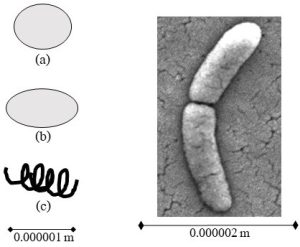
Relevance to humans. Their extensive roles in Earth’s systems make bacteria as vital to us as to any other organism. Additionally, though, they interact directly with humans in important ways: some can harm us by causing diseases such as strep throat, gonorrhea, cholera, and tuberculosis, whereas some provide benefits through aiding in digestion and helping to keep harmful microorganisms out of our bodies (see Chapter 1 for more on these two phenomena).
Fungi
Moderate complexity. These are eukaryotic, colonial or unicellular, fast growing and short lived. Some forms are motile, others are largely stationary.
Adaptability. Fungi can adapt to changing surroundings, but their more complex cell structure makes them slower to do so than are bacteria.
Distribution. It would not be appropriate to call fungi ubiquitous (just one way they are distinct from bacteria). However, they are found in many environments and can survive harsh conditions like low availability of water and food. Most require oxygen, but a few, namely yeasts (famously responsible for the fermentation of grain to alcohol) do not. Fungi can be found in soil, air, and water, as well as in or on other organisms.
Nutrient sources. Different fungi have the capacity to use different food types, but the list of potential nutrient sources is far shorter here than it is for bacteria. Most of them digest the remains of dead organisms, and some will also break down synthetic pollutants (Chapter 15). Importantly, certain members of this group can manage very large and unwieldy materials: they release substances into their surroundings that begin the process of digestion outside of their cells. When the materials have been reduced in size, they can enter the fungal cells and provide needed nutrients. Unlike certain bacteria (and algae, which we will explore next), fungi cannot obtain energy from the sun.
Roles. In most systems, fungi are decomposers. In short, they break down waste products and remains of other organisms; this action helps to recycle important nutrients (we will see more about decomposition in Chapters 4 and 5).
Physical forms. As a group, fungi are physically diverse relative to bacteria. Fungi can take on many different shapes, sizes, and colors. Additionally, fungi include unicellular forms like anaerobic yeast as well as large multicellular forms like mushrooms and bread mold. Individual cells are about ten times larger than those of bacteria (about 10 microns, 0.00001 meters), but still microscopic. Figure 3.12 shows two of the many forms fungi can take (see Box 3.3 for some thoughts on how fungi like the large ones in the figure can be classified as microorganisms).
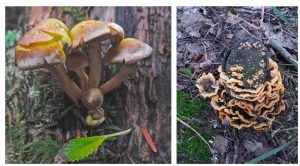
You might be wondering why a group that includes the clearly visible mushroom is classified as a microorganism. The explanation is that the mushroom is only the above-ground portion of a large network of largely microscopic cells that grow in soil. Also, because of certain other traits, many organisms visible during some part of their life cycle are simply grouped here. Be all that as it may, it still is a bit confusing, and there is not 100% agreement that mushrooms should be on this list. The common characterization of algae (below) as microorganisms results from similar considerations.
Algae
Moderate complexity. Like fungi, these are unicellular or colonial eukaryotic organisms. Algae can be mobile or stationary.
Adaptability. As eukaryotes, they are less readily adaptable than prokaryotes.
Distribution. Algae require light to grow (as described below), so they rarely are seen in dark environments. They also tend to require water, so they are common in rivers, lakes, oceans, and wet surface soil.
Nutrient sources. As we will see in Chapters 4 and 5, some organisms, including algae, can use the sun as an energy source and convert important building blocks like carbon atoms from unusable to usable forms. So, unlike fungi, they do not consume remains of other organisms
Roles. Their ability to convert light energy and carbon into usable forms means algae can provide nutrients to organisms that cannot carry out those important conversions. Put another way, they act as food for other organisms. Again, Chapters 4 and 5 will expand on this topic.
Physical forms. Like fungi, this group includes truly microscopic forms such as diatoms, as well as giant kelp, organisms that can be two or more meters long (recall Box 3.3). Individual cells are similar in size to those of fungi, about 10 microns (Figure 3.13).
Relevance to humans? Algae play very important roles in many systems on Earth, so they are obviously indirectly relevant to us (Chapter 4 and 5). Otherwise, we interact with them less than we do with bacteria and fungi. Human diseases caused by algae are rare, and although some are edible, algae play only a minor role in meeting the nutritional needs of most people.
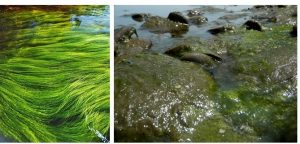
Protozoa
Moderate complexity. These organisms are generally unicellular (a few are colonial), eukaryotic organisms. Protozoa are mobile.
Adaptability. They are less readily adaptable than are prokaryotes, although their DNA is simple relative to that in animals.
Distribution. Protozoa can be found in soils, water, and inside organisms, but not in places with extreme conditions of temperature or chemical properties.
Nutrient sources. By and large, protozoa are like fungi in their need for nutrients. Then tend to eat bacteria and other microorganisms or free-floating debris that originated from organisms.
Roles. Protozoa both eat smaller organisms and serve as food for larger organisms. They are therefore an integral part of the recycling of materials in natural systems.
Physical forms. Compared to bacteria, this group includes organisms with a range of diverse forms. Like fungi and algae, individuals are also approximately 10 microns in size (Figure 3.14).

Relevance to humans? Protozoa are directly important to us largely because of the diseases they can cause. As unlucky hikers and campers can tell you, extreme intestinal distress can be the result if an organism called Giardia lamblia ends up in your gut. It can be consumed through contaminated water and has the potential to be lethal due to the massive dehydration it brings about.
Viruses
These acellular (i.e., not, or without, cells) entities are not proper organisms like the others on this list, but they are clearly biological and relevant to us. The details of their existence are beyond the scope of this textbook, but a few important properties and roles are worth noting. Put simply, viruses invade the cells of other organisms: microorganisms, plants, and animals are all susceptible to attack. Once inside a cell, they can use the machinery of their host to make copies of themselves. In fact, viruses depend on their hosts for reproduction and transportation. A possible consequence of viral infection is disease, that is, the host organism is damaged. A very short list of human diseases caused by different viruses includes COVID-19, herpes, AIDS, Ebola, and the common cold. Finally, they are extremely small, on the order of 0.01 – 0.001 microns. Put another way, bacteria are 100 to 1000 times larger than a typical virus. See Box 3.4 for more about microbial sizes.
By now you should realize that, although all are invisible to the naked eye, microscopic organisms are far from uniform in size. We have seen an enormous range, from tiny viruses that are 0.000000001 meters (0.001 microns) to giant protozoa that can sometimes top out at nearly 0.001 meters (1000 microns). Keep in mind that there is at least as much of a size difference among microbes as we see in our macroscopic world (say, a whale vs. an insect). If we include even smaller, non-living entities like atoms and other particles (Chapter 4), the range within the invisible world increases by at least another 1000 fold or so. Clearly, “small” is a term fraught with uncertainty.
3.2.3. Earth’s oldest organisms
Most scientists accept that prokaryotes have dominated this planet for most of its history and are likely to do so into the future. Recall from our look at geologic time, above, that evidence of single-celled lifeforms is 3.8 billion years old, whereas multicellular organisms did not arrive until 600 million years ago. Interestingly, although an examination of data strongly suggests that the earliest bacteria specialized, evolved, and eventually gave rise to the rest of the biosphere, many modern-day prokaryotes still seem to closely resemble their ancient ancestors. So, microbiologists have been able to learn a lot about ancient organisms by studying current ones. Additionally, information gleaned from studies of bacteria has provided a lot of data about the development of eukaryotes. Knowledge about them also informs our study of the development of Earth’s physical environments. As we know, the geologic time scale employs biological criteria to establish its organization and chronology. We will look more at the development of living things and the mutual effect they and their environments have on each other in Chapters 5 and 6.
3.2.4. Applications of microbiology
Knowledge of microbiology is applied to many areas we value as both scientists and citizens of the modern world.
Medicine and public health
As noted above, different kinds of microorganisms can make us sick, with consequences ranging from mild to severe. Any organism that can cause disease is termed a pathogen. Although most microorganisms are not harmful to us, those that are receive a great deal of attention. Notably, we use information about factors affecting their survival to help improve public health. Box 3.5 describes how science was used historically to understand the ways microorganisms bring on diseases and other undesirable effects.
Box 3.5. Disease, food spoilage, and magically appearing mice: get me a scientist!
We saw in Chapter 2 that the scientific method can be used to better understand the rules governing the universe and to test explanations about important phenomena. Widely held assumptions, even those not supported by solid evidence, can be difficult to discredit, and the efforts of multiple scientists working during decades or centuries are often necessary to alter entrenched theories. For example, several ideas about the causes of illness and various kinds of contamination were evaluated and ultimately rejected only after many years of scrutiny. Two important instances of paradigm shifts are worth a few minutes of our attention here because they demonstrate how knowledge evolves as well as the way science can be used to challenge even long-standing beliefs.
1. What causes disease? Most modern people know that specific entities—often referred to as germs—can move among animate and inanimate objects to induce infectious diseases. People of the past, however, did not have access to such information and lived in a world dominated by microscopic forces they did not understand. One of the more vivid historical examples of the way ignorance led to suffering occurred in Europe of the middle 1800s, near the start of the Industrial Revolution. During this period, The Thames River in London, England, became increasingly polluted due to the rapid growth of the human population in the city. Since indoor plumbing was not yet available, and the river was a moving and ever-present receptacle, people dumped their excrement into its water. Other trash ended up in there as well. Unfortunately, The Thames also served as the major source of drinking water for many Londoners. Apart from the aesthetic reasons that are likely obvious, drinking human sewage is a very bad idea because it contains a high density of microscopic pathogens. Perhaps not surprisingly, an epidemic of water-borne cholera devastated the population, causing the deaths of many thousands in a short period of time. It may seem inconceivable that people would consume their own waste, but subsequent scientific inquiry has revealed to us two things the citizens of 1850s London did not realize: infectious diseases are caused by discrete biological entities, and human feces contains a lot of pathogens. It was a study of this very cholera outbreak that led to some important new knowledge about the transmission of human diseases. A physician named John Snow noticed that rates of cholera infections were far higher among people who drank from the river than in those who used different sources of water. He hypothesized that something carried in the water was responsible for the disease, not so-called bad vapors (known as miasma), the prevailing explanation at the time. How did Snow test his hypothesis? He convinced the city leaders to shut off access to the river and force people to haul drinking water from inconvenient wells located some distance away. The result: cholera rates dropped dramatically, and public health microbiology took a giant leap forward. We will return to the methods we currently use to slow the spread of diseases like cholera, notably the ways we minimize the amount of sewage released into our drinking water, in Chapter 11.
2. Who put the bacteria in the potato salad? The reason foods like milk, meat, and various mysterious leftovers can go bad is generally known to have something to do with the action of microbes. Like we saw above with diseases, though, people of the past did not understand the mechanism by which food becomes rotten and inedible. One of the most persistent historical explanations for food spoilage (and contamination in a broader sense) was called spontaneous generation. For centuries, people assumed that the organisms responsible for spoilage arose from within food, not from without. We know today that the mold and other agents growing on a loaf of bread after a few weeks got there due to contamination, that is, fungal spores, bacterial cells, or even insect eggs were transferred in from a source external to the food. Even more remarkable to a modern audience, the appearance of rodents inside piles of dirty clothes or food pantries was typically attributed to spontaneous generation rather than the movement of such pests into places they found attractive and habitable: yes, instant, fully grown mice! Why did this explanation of contamination seem reasonable enough to dominate for so long? In short, scientists made simple observations of materials before and after they rotted and concluded that the newly appearing organisms had to be produced by those materials. Although maggots could be seen with the naked eye, the eggs (which eventually hatched into those maggots) laid by flies landing on the food were not so obvious. In some ways, the development of the microscope in the 17th Century caused even more confusion because it allowed scientists to see clear differences between unspoiled and spoiled food, with the former lacking microorganisms and the latter teeming with them. Unfortunately, it did not reveal the cells landing on fresh food and their early stages of growth. Only the end result, obvious spoilage, was observable. People who did not accept the prevailing paradigm, as is so often the case, used the scientific method to both challenge spontaneous generation and test hypotheses about alternate explanations. As early as the 1600s, experiments were conducted to assess whether covering food would prevent contamination. Sure enough, when all other variables were equal, exposed meat ended up infested with maggots, whereas meat sealed in a container did not. Despite these findings, spontaneous generation was not generally rejected until Louis Pasteur conducted a rather famous experiment in the 1800s. In essence, he showed that sterile liquid remained so until and unless it was exposed to non-sterile air. The belief that organisms could pop out from the center of non-living material was finally debunked—after centuries of tests!
Food and drink
Humans have learned how to harness microorganisms to produce foods like cheese, yogurt, and bread, as well as beer and wine (noted above). The science of microbiology, therefore, can profoundly affect nutrition and economic well-being.
Waste clean-up
As we will see in Chapters 11, 13, and 15, some microorganisms are able to break down our unwanted materials. A lot of research is done to optimize the growth and activity of the bacteria and fungi that provide such valuable services to us.
Agriculture
The actions of certain microorganisms are critical to the recycling of nutrients used by crops. We will return to this topic in Chapters 4 and 9.
THE CHAPTER ESSENCE IN BRIEF [2]
The science of geology allows us to study Earth’s past and present as well as its future trajectory. It provides knowledge about the physical forces shaping organisms and materials vital to humans. An understanding of microbiology gives us insights into the largely unseen organisms without which our lives would be impossible.
Think about it some more…[3]
Why do environmental scientists care about Earth’s history? What difference does it make to those of us living today?
Do you think the theory of plate tectonics is appropriately known as a “theory”? Would you prefer to call it a “conclusion” or a “law” (as those terms are described in Chapter 2)? Why?
Would you assume that bacteria and other organisms too small to be seen with the naked eye exist if you could not see them directly? What evidence do we have that they are all around us?
ADDITIONAL RESOURCE
See also a link to the time scale as endorsed by the USGS: http://pubs.usgs.gov/fs/2007/3015/fs2007-3015.pdf
- Modelled on USGS and Geological Society of America time scales. ↵
- As you will find throughout this book, here is very succinct summary of the major themes and conclusions of Chapter 3 distilled down to a few sentences and fit to be printed on a t-shirt or posted to social media. ↵
- These questions should not be viewed as an exhaustive review of this chapter; rather, they are intended to provide a starting point for you to contemplate and synthesize some important ideas you have learned so far. ↵
A geology term referring to distinct units of the lithosphere. Several of these large plates make up the lithosphere, and they move around, on top of the asthenosphere, with respect to each other. Their movements are responsible for many important phenomena, including continental drift, earthquakes, and volcanoes. See Chapter 3 for more.
A large mass of ice that persists for many years (up to hundreds of thousands) despite changing seasons. It is formed through accumulation and compression of snow into ice. Glaciers can profoundly shape the surface as they slowly move, store a lot of freshwater, and contain clues about past climatic and atmospheric conditions. See Chapters 4 and 14 for more.
In geology, an ancient landmass made up of all Earth's continents. It started to break up due to movement of tectonic plates about 200 million years ago. See Chapter 3 for more.
Defined by geologists as materials that are naturally occurring, solid, consolidated (i.e., grains glued together through some mechanism), and made up of some combination of inorganic minerals and remains of organisms. More about the three types of rocks and the rock cycle can be found in Chapter 3.
The remains of an ancient organism. Such remains can take many forms, including impressions in rocks or chemical remnants that were transformed into fuels such as coal, oil, and gas. See Chapters 3 and 10 for more.
A biochemical molecule containing the code that makes every organism unique. See Chapter 6 for details.
Refers to a broad class of chemical compounds intended to kill unwanted organisms. Widely used in agriculture, they can kill pests such as weeds, certain insects, and others, but they also can harm organisms we wish to protect, including humans. See Chapters 1, 9, and 15 for more.
A metric unit of length that is equal to 0.0000001 meter. The abbreviation for this unit is µm. See Chapters 2 and 3 for more.
A cell that consists of discreet, membrane-enclosed subcellular structures like nucleus, chloroplast, ribosomes, and mitochondria. Contrast with prokaryotic cell. Also known simply as 'eukaryote'. See Chapter 3 for more.
Refers to organisms that are built of multiple cells, but those cells do not specialize and communicate with each other to the same extent as cells in true multicellular organisms. Compare to unicellular and multicellular. See Chapter 3 for more.
An organism that consists entirely on a single cell. Bacteria are unicellular. Contrast with multicellular. See Chapter 3 for more.
In response to environmental pressures, organisms develop strategies that allow them to survive and reproduce in a particular area. In ecology, a characteristic or trait that an organism develops in response to pressures placed on it by its environment is called an 'adaptation'. Well-adapted organisms posses the traits that allow them to be present in their current environment. Organisms with the best adaptations will be most successful in their environment (barring a random event that could disrupt them). Some simple examples of adaptations: fish have gills to extract oxygen from water, thus they can survive in water; cheetahs are very fast, thus they can catch prey in open landscapes; certain bacteria can withstand very acidic conditions, thus they can live inside the human stomach. See Chapters 1, 5, and 6 for more.
A general word that refers to the breaking down of relatively large, complex materials into relatively small, simple materials. Certain organisms, known as decomposers, break down the remains and waste products of other organisms and use those products as nutrient sources. Decomposers are critical to the health of ecosystems because they aid in the recycling of materials. Fungi and some bacteria are important decomposers. See Chapters 4 and 5 for more.
Refers to the many different kinds of microscopic organisms that are single celled and prokaryotic (i.e., do not possess distinct cellular organelles). Collectively, bacteria are extremely diverse, are the oldest organisms on Earth, and are critical to many environmental cycles and processes. See Chapter 3 for more.
A type of organism that lacks any membrane-bound organelles such as a nucleus. These tend to also be small and single celled. Bacteria are important prokaryotes. Also known simply as 'prokaryote.' See Chapter 3 for more.
